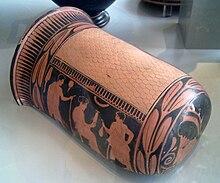Epinetron

An epinetron ( Greek ἐπίνητρον ) is a in the 5th century BC. A device developed in ancient Greece for preparing (“ taking off”) spinning wool . The epinetron is often incorrectly referred to as Onos , but according to ancient evidence, this is probably a kind of footstool that plays a role in the wool processing with the epinetron.
The Epinetron is a kind of cylinder that is cut in half lengthways and provided with a lock on one narrow side. The handling of an Epinetron is described by Hesychios . Then it was placed on the thigh and then the already spun wool thread was pulled over the rough surface to roughen it before it was further processed.
In the Attic period they developed into a popular cult object and were often given to unmarried girls as grave goods. The epinetron was made of clay or wood; Numerous specimens painted by vase painters have survived.
literature
- Ingeborg Scheibler : Epinetron. In: The New Pauly (DNP). Volume 3, Metzler, Stuttgart 1997, ISBN 3-476-01473-8 , Sp. 1146.
- Frauke Heinrich: The Epinetron. Aspects of the female world as reflected in a piece of work equipment (= International Archeology 93). Leidorf, Rahden / Westfalen 2006, ISBN 3-89646-365-9 (also: Bonn, Univ., Diss., 2004).
